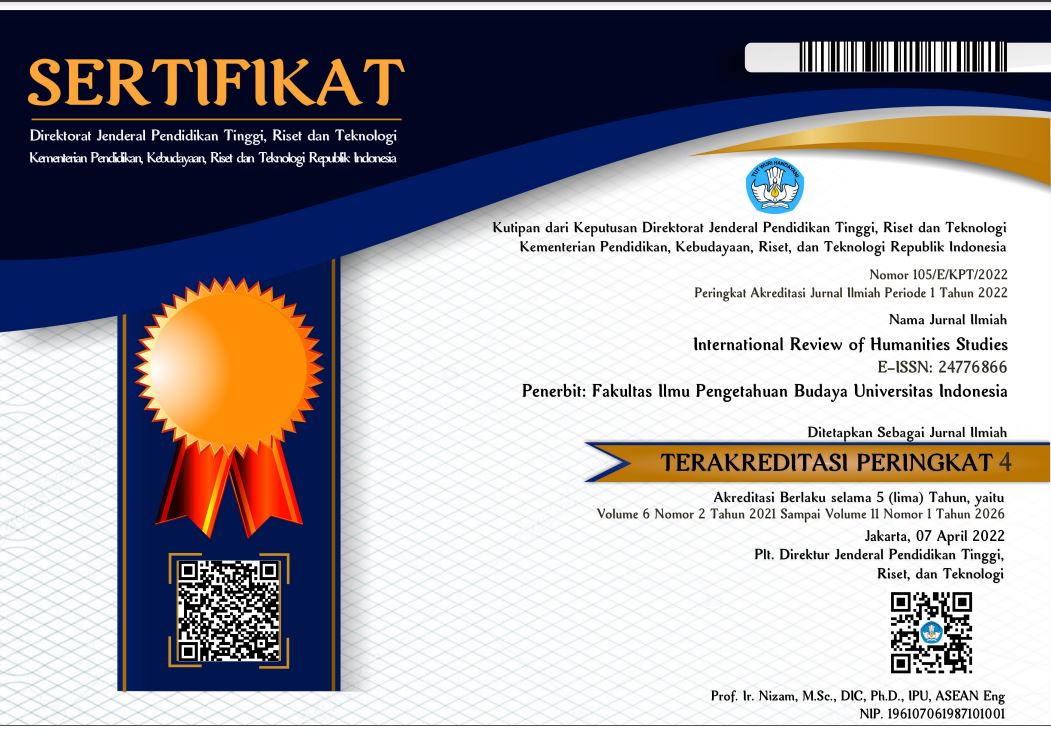International Review of Humanities Studies

Abstract
Education, especially children's character education, is very important. Education can be carried out in formal and non-formal educational institutions. One of the learning media that can be used is through traditional cultural arts.The traditional Javanese cultural art that is the object of this research is the Bondhan Payung dance, which is taught at Sanggar Ayodya Pala Cibinong and PPKB FIB UI. The selection of Bondhan Payung dance as the object of research with the consideration that in Bondhan Payung dance contained teaching values that are important for teaching children's character.This research uses a qualitative approach by applying the concept of triangulation. Data as well as information are based on observations of the practice process in class, interviews with trainers and parents of students. The results of this research found a positive influence of character training through Bondhan Payung dance media on children's characters.
References
Aithal, S., Karkou, V., Kuppusamy, G., & Mariswamy, P. (2019). “Backing the backbones: A Feasibility Study on the Effectiveness of Dance Movement Psychotherapy on Parenting Stress in Caregivers of Children with Autism Spectrum Disorder”. The Arts in Psychotherapy. 64, 69-76.
Andina, Y. R. (2023.) Musik Untuk Kesehatan Mental. Kementrian Kesehatan Direktoral Jenderal Pelayanan Kesehatan. 2023.
[https://yankes.kemkes.go.id/view_artikel/2231/musik-untuk-kesehatan-mental#:~:text=Musik%20merupakan%20alat%20merelaksasikan%20pikiran,suasana%20hati%20menjadi%20lebih%20baik.]
Ayuningtyas, D., & Rayhani, M. (2018). “Analisis Situasi Kesehatan Mental pada Masyarakat di Indonesia dan Strategi Penanggulangannya”. Jurnal Ilmu Kesehatan Masyarakat. 9(1), 1-10.
Denkin. N.K. (2012) “Triangulation 2.0”, Journal of Mixed Methods Research. SAGE. [https://journals.sagepub.com/doi/10.1177/1558689812437186]
Douka, S., Zilidou, V. I., Lilou, O., & Manou, V. (2019). “Traditional dance improves the physical fitness and well-being of the elderly”. Frontiers in Aging Neuroscience, 75.
Duberg, A., Möller, M., & Sunvisson, H. (2016). “I Feel Free: Experiences of a Dance Intervention for Adolescent Girls with Internalizing Problems”. International Journal of Qualitative Studies on Health and Well-being, 11(1), 31946.
Green, T.A. (1997). Folklore: An Encyclopedia of Beliefs, Customs, Tales, Music, and Art. English: ABC-CLIO,
Santa Barbara, Calif. Hasan, C. (1994) Dimensi-Dimensi Psikologi Pendidikan. Surabaya: Al Ikhlas.
Hobsbawm, E. & Ranger, T. (2014). The Invention of Tradition. Cambridge University Press.
Jazuli, M. (2008). Pendidikan Seni Budaya Suplemen Pembelajaran Tari. Semarang: Universitas Negeri Semarang.
Koch, S.C., Riege, R.F.F., Tisborn, K., Biondo, J., Martin, L. and Beelmann, A. (2019). “Effects of Dance Movement Therapy and Dance on Health-Related Psychological Outcomes. A Meta-Analysis Update”. Frontiers in Psychology.
Kristinawati, W. & Naklui, D. S. (2022). “Menari dan Kesehatan Mental”. Buletin KIPN. Vol. 8 No. 17 September 2022.
Nasution, S. (1989), Kurikulum dan Pengajaran. Jakarta: Bumi Aksarahal.
Poerwadarminta. (1939). Bausastra Jawa. Maatschappaij N.V. Groningen Batavia: J.B. Wolters Uitgevers.
Saryono. (2010). Metode Penelitian Kualitatif. Bandung: PT Alfabeta.
Walton, L., Domellöf, M. E., Åström, Å. N., Elowson, Å., & Neely, A. S. (2021). “Digital Dance for People With Parkinson's Disease During the COVID-19 Pandemic: A Feasibility Study”. Frontiers in Neurology, 12.
Recommended Citation
Prasetiyo, Ari
(2024)
"CHILDREN'S CHARACTER EDUCATION THROUGH BONDHAN PAYUNG DANCE,"
International Review of Humanities Studies: Vol. 9:
No.
1, Article 17.
DOI: 10.7454/irhs.v9i1.1284
Available at:
https://scholarhub.ui.ac.id/irhs/vol9/iss1/17
Included in
Anthropology Commons, Art and Design Commons, Creative Writing Commons, Cultural Heritage Law Commons, Education Law Commons, Film and Media Studies Commons, History Commons, Intellectual Property Law Commons, International and Area Studies Commons, Legal Writing and Research Commons, Linguistics Commons, Museum Studies Commons, Philosophy Commons, Urban Studies and Planning Commons


